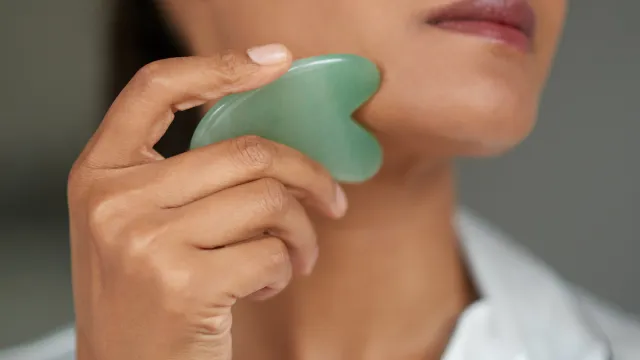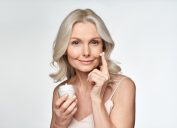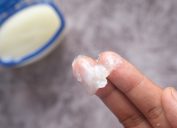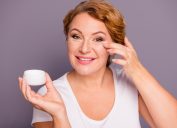How to Use a Gua Sha Stone Properly: A Step-by-Step Guide
The ancient tool could have major benefits for your skin.
Talking about skincare routines is one of social media's favorite hobbies. Over the past few years, we've seen things like microcurrent and hydra facials take off, as well as countless lotions and potions with endless promises. But one technique that's stood the test of time is gua sha—and so you might be wondering how to use a gua sha stone. To find out, we turned to the experts. Keep reading to learn how gua sha works and the benefits it provides.
RELATED: 104-Year-Old Woman Reveals Her Anti-Aging Skincare Routine.
What Is Gua Sha?
Gua sha is a massage technique where you stroke your skin with a stone to achieve a range of benefits, from reduced puffiness to a more lifted appearance. Gua sha face massages are quite popular on TikTok, where beauty influencers share their morning and evening skincare routines that include the tool. According to Google Trends, inquiries about gua sha reached peak popularity in 2021 and have remained popular ever since. If you have a skincare aficionado in your friend group, then they probably have this tool—and likely rave about it.
Although the gua sha practice has experienced a more recent surge in popularity, the methodology is ancient. "Gua sha is a traditional Chinese medicine technique that is used to treat and improve the health of the skin and body," says Elizabeth Trattner, a doctor of Chinese and integrative medicine and acupuncturist who teaches gua sha. "It's becoming very popular now because of the dramatic effects it has on lifting and shaping the face."
What Are the Benefits of Using a Gua Sha Stone?
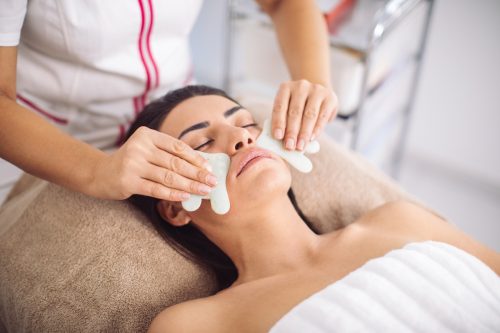
- Anti-Aging: One of the biggest draws to gua sha is the anti-aging effects. "Some say it can relax the facial muscles and help reduce the appearance of wrinkles," says Christopher Chu, board-certified dermatologist and founder of Pure Dermatology.
- Increased Circulation: The repeated massage motion could boost your blood flow. "In one published study, gua sha improved the blood circulation in the skin, which could help improve skin health," Chu adds.
- Increased Collagen Production: Some proponents say the practice can increase the creation of collagen, which is the protein that gives your skin its youthful, bouncy quality and tends to decrease as we age.
- Lymphatic Drainage: "Enhancing lymphatic drainage reduces puffiness and promotes a more sculpted appearance—although this is very temporary," says Diley Banh, cofounder of aesthetics clinic Juicy Face.
- Relieve Tension: Like any massage, a facial massage using the gua sha technique can ease tension in the areas where you use it. Some of the pros we chatted with said it may also improve TMJ symptoms.
- Reduces the Appearance of Acne Scars: The increased blood flow due to boosted circulation could aid this process.
- Reduces Puffiness: This one's related to lymphatic drainage. "In my opinion, gua sha can probably improve blood flow to the skin and help reduce puffiness temporarily, but more research needs to be published to confirm the long-term benefits," says Chu.
RELATED: 8 Skincare Ingredients That Help Hide Your Wrinkles, Experts Say.
What Kind of Gua Sha Stone Should I Buy?
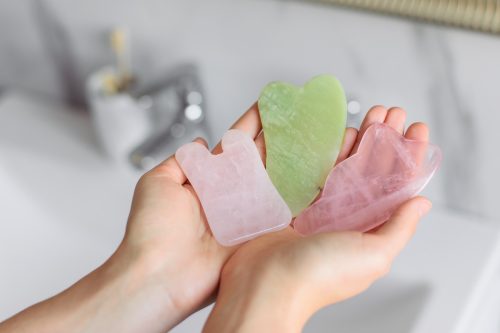
Materials To Consider
Walk into your local beauty shop, and you're bound to find dozens of gua sha stones. "Gua sha tools come in all minerals like jade, rose quartz, bian stone, obsidian, quartz, agate, and other new stones, and all work because it's the type of massage that creates the benefit," says Trattner. "The mineral used for the massage is a bonus."
If you want to select one with extra properties, opt for jade. "It is said that jade has the same hertz as the human body," says Trattner. Most traditional practitioners use it, too.
Shapes To Consider
Again, Trattner says the shape of your gua sha stone isn't all that important as long as your technique is on point. However, she has a favorite: "I prefer the traditional H shape or heart shape because they are easy to use," she says.
How Can I Give Myself a Gua Sha Facial?

Clean Your Face
The first step in your gua sha routine should be to wash your face with your usual gentle cleanser to remove makeup, oil, and dirt. "This helps the gua sha tool glide smoothly and prevents any impurities from being massaged into your skin," says Chu.
Apply an Oil or Moisturizer
Next, Trattner suggests misting your face, neck, and chest with a toner or water. "Following that, apply an oily serum, facial oil, or slippery face lotion to the neck, face, and chest," she says.
Perform Your Gua Sha Workout
Now, you're ready for the massage.
While you might see some influencers perform gua sha on their face only, Trattner says it's imperative to begin in the chest area. This moves lymphatic tissue and stimulates the proper acupuncture points. "It is impossible to sculpt the face if there is stagnation or congestion elsewhere," she says.
To begin, hold the gua sha tool with your thumb on one side and four fingers on the other. Position it at a 15-degree angle to your chest and move it from the center of your chest to the side slowly and with light pressure. After three to seven strokes on each side, you can move to the neck.
Move the gua sha up the midline of your neck, essentially on your throat, and wiggle it at the jawline. Then, switch to the longer side of the tool and move it up the sides of the neck; wiggle at the jawline. Finally, go up the back of the neck.
When you get to the face, Trattner suggests using the notched edge of the gua sha to move along the jaw toward the ears. Continue up the face moving from the the center to the sides and up toward the temple. You should trace the bone of the eyebrow but not use the gua sha in the eye socket. "At the forehead, make a fan shape going into the hairline—then, go midline out," says Trattner.
Repeat each stroke three to seven times, using gentle-to-medium pressure.
Rinse With Lukewarm Water
After your gua sha workout, rinse your face with lukewarm water and continue your skincare routine as usual.
Clean Your Tool and Store It Safely
You can clean your gua sha tool with a facial cleanser or a gentle antibacterial soap. Store it somewhere dry and protected from dirt and grime.
RELATED: 8 Skincare Mistakes That Make You Look Older.
Where Else Can I Use a Gua Sha Stone?
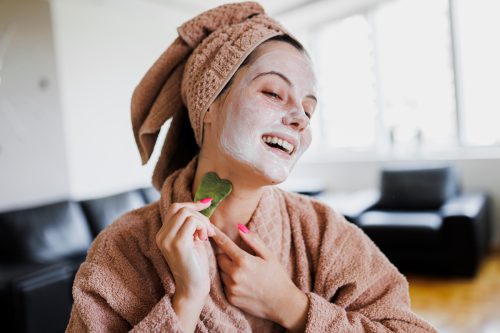
Facial gua sha is the most popular, but many practitioners suggest using it on other parts of the body for more comprehensive results.
- Neck: You can use the gua sha on the sides and back of the neck and wiggle the stone once you reach the jaw. Use a gentle touch, especially near the carotid artery.
- Back: One 2019 study found that people who used gua sha for lower back pain experienced a reduction in pain. In order to do this, you'll need to visit a practitioner.
- Throat: You can swipe the gua sha up your throat in a similar way as your neck.
Are There Any Downsides to Gua Sha Treatments?
According to Chu, gua sha is a minimally invasive technique, so there aren't a lot of downsides. However, there are a few things you may notice. "Some people may see bruising or soreness if too much pressure is applied," he says. "There may also be temporary redness due to increased blood flow." If you notice either, use a gentler stroke the next time you gua sha.
Reasons to Put a Pause On Your Gua Sha Routine
There are a few times you should skip the gua sha. "It's not advised with pregnancy, being on blood thinners, fever, cancer, sunburn, and open sores or acne on the face," says Trattner.
You'll also want to consider any aesthetic procedures. "If you have had any anti-wrinkle treatment such as Botox or dermal filler treatment, you should avoid gua sha for two weeks," says Banh. "Gua sha after injectables may lead to a high risk of infections."
RELATED: 10 Daily Habits That Keep Your Skin Young and Glowing.
So, Is Investing in a Gua Sha Stone Worth It?
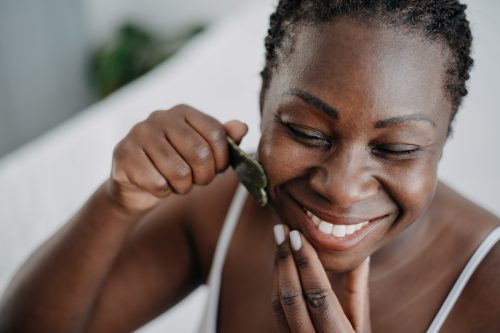
Most dermatologists agree that the long-term results of gua sha are understudied but that there may be some noticeable short-term benefits. That said, many gua sha buyers seem happy with their purchase.
A review of the Mount Lai Gua Sha Facial Lifting tool said: "Several people have asked me if I lost weight, but I definitely have not- my face is just holding less fluid and is much more defined." Another person commented: "It feels great, and is very relaxing. I couldn't tell if it was doing anything for my skin or it was just in my head but then on a Zoom call yesterday someone complimented my 'rosy glow'!"
Your initial investment will depend on whether you choose to do gua sha at home or get it done by a professional. Home gua shas cost anything from a few dollars to hundreds (though experts agree the differences between the two are minimal). If you go to an aesthetician, the treatment will likely cost around $60 to $100, depending on what else you have done.
The biggest benefit of DIY gua sha is the frequency. If you incorporate the massage into your daily routine, you'll be able to do it more consistently than if you only do it in an aesthetician's office. That alone could be the difference between seeing results and not.
Conclusion
Having evolved out of an ancient Chinese practice, the gua sha we practice today remains safe for most users and could be a welcome addition to your skincare routine, especially if you purchase an affordable stone—just be aware of how you use the stone with certain medical conditions. For more beauty advice, visit Best Life again soon.
Best Life offers the most up-to-date information from top experts, new research, and health agencies, but our content is not meant to be a substitute for professional guidance. If you have health questions or concerns, always consult your healthcare provider directly.
